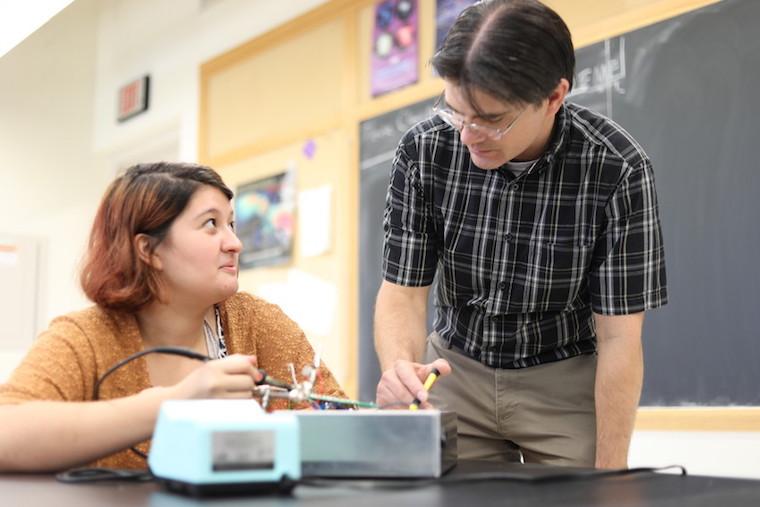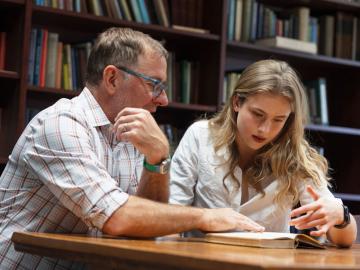STRONG Returns for Its Fourth Year
September 20, 2018
Erin Ulrich ’18

STRONG brings incoming first-year students from underrepresented demographics in STEM to campus early, showing them that they have a place in these disciplines.
Science and Technology Research Opportunities for a New Generation (STRONG) returned this summer with a cohort of eight incoming first-years participating in research activities ranging from conducting interviews for the citywide environmental dashboard to searching for dark matter. To be eligible for the STRONG program, students must either be women, Pell-eligible, students of color, or the first in their immediate families to attend college. Since its inception in 2015, STRONG has paired first-year students with Oberlin College professors in STEM fields to conduct research together.
STRONG intentionally introduces students typically underrepresented in STEM fields to college-level research—allowing them to delve into their fields of interest before taking their first college class. STRONG scholars fresh out of high school are immersed in research with professors—something that typically requires students to demonstrate significant diligence, even as upperclassmen.
Assistant Dean of the College of Arts and Sciences, Director of Undergraduate Research, and Assistant Professor of Comparative American Studies and Africana Studies Afia Ofori-Mensa, who designed the program in 2014 and has since served as STRONG program director, says that the approach the program takes around issues of belonging, identity, and care, are relevant not just to STEM fields, but to institutions of higher learning as a whole.
Ofori-Mensa says, “The idea with STRONG is that if underrepresented students want to remain in STEM, they should be able to remain in STEM. It is not skills, or even resilience, that those students are often lacking. It is things like confidence—their own confidence in themselves and the confidence of others in their capabilities—and a sense that they belong here, in this place that may feel so different from everything they’re used to.”
Although the program lasts for five weeks, the professors involved in the program are committed to seeing through their students’ success long after the program ends. Many STRONG scholars go on to participate in research with their program leaders-turned-mentors, even choosing them as advisors for their senior theses.
True to the program’s mission to make research accessible, STRONG scholars earn a $2,000 living stipend for conducting full-time research throughout the program, funding to cover travel expenses to and from Oberlin, as well as to help pay for textbooks their first year.
But STRONG is about more than introducing scientifically gifted first-years to the often intimidating space of a college lab. STRONG scholars get a head start adjusting to college life—meeting twice a week for workshops designed to prepare them for their undergraduate courses, such as Math for Science and Study Skills and Time Management.
The nature of the program’s eligibility requirements necessitates that the professors involved reflect on the makeup of their respective fields. Associate Professor of Physics and Chair of Physics and Astronomy Jason Stalnaker says that Oberlin’s commitment to demonstrating a continued interest in this type of programming goes deeper than the institution’s concerns.
“Physics is notoriously bad at representation—if you go to conferences it’s 80-90% white males. I think Oberlin’s long history of inclusion is one of its strong points, and STRONG is an example of this. To me, it’s broader than Oberlin,” Stalnaker says.
While students selected for the program benefit in obvious ways, the program also enhances professors’ abilities to advance their research during the summer. Paul Sears Professor of Environmental Studies and Biology John Petersen says, “The reality is that I’m really looking for good students who are at a level in which they can participate and be colleagues in my research.”
“I think all students benefit from community-engaged learning,” says Petersen. “At the end of the day, one of Oberlin’s goals is and should be to prepare students to be successful agents of change in the larger world. The community of Oberlin and surrounding regions that we’re working with are the real world. The cty of Oberlin is a small community, which means that we can affect change fairly rapidly with personal engagement.”
In addition to their propensity to becoming leaders—or “experts in Oberlin,” as Petersen calls them—STRONG scholars have a special opportunity to develop relationships and receive advice from their peers, many of whom are advanced undergraduates helping out in professors’ labs. Associate Professor of Biology Maureen Peters says, “Integrating an incoming student with continuing students allows STRONG scholars to have a larger support community, including near peers who can share valuable information about their personal path in STEM at Oberlin—the highs and the lows—as well as practical information like how to find ‘K’ vs. ‘A’ rooms in the Science Center.”
Friendly faces are more than just a perk of the program—these student connections act as a catalyst for incoming STEM students to ask questions, seek the resources they need, and simply be able to see themselves as leaders in the fields they’re passionate about.
Assistant Professor of Neuroscience Leslie Kwakye leads a STRONG research group and believes Oberlin is poised to be at the forefront of conversations around representation in STEM. She says, “These underrepresented individuals in STEM have the potential to offer novel viewpoints in scientific research and medicine and to reshape the priorities of scientific endeavors in such a way as to better serve disadvantaged groups.”
Ofori-Mensa echoes the idea that STRONG scholars are not only prepped to be leaders, but that programs like this can transform the way STEM fields think about the places of typically underrepresented scientists. She says, “I’ve noticed that one of the most pronounced effects of STRONG so far is that STRONG scholars identify strongly as scientists. They tend to declare their majors earlier than others in their class, a lot of them within their first year. They come into college identifying with STRONG, and because STRONG is a STEM program, it also means they identify with STEM.”
Tags:
You may also like…
Oberlin Summer Research Institute Partners with Career Exploration and Development, Expands Capacity
January 17, 2025
For almost 20 years, Oberlin Summer Research Institute, or OSRI, has been fostering community and the development of Oberlin students. Now, beginning in summer 2025, the program will offer exciting new opportunities.
Ava Harvey ’26 Earns Leadership Alliance Summer Research Fellowship
August 8, 2024
Ava Harvey ’26 received a Summer Research Early Identification Program (SR-EIP) Fellowship from the Leadership Alliance.
Freya Kailing ’25 Named 2024 Goldwater Scholar
August 7, 2024
Freya Kailing ’25, a biology major from Kalamazoo, Michigan, received a 2024 Goldwater Scholarship, a prestigious award for college students planning research careers.


